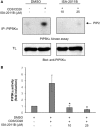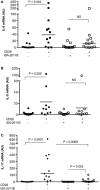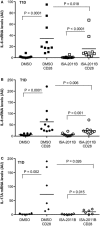ISA-2011B, a Phosphatidylinositol 4-Phosphate 5-Kinase α Inhibitor, Impairs CD28-Dependent Costimulatory and Pro-inflammatory Signals in Human T Lymphocytes
- PMID: 28491063
- PMCID: PMC5405084
- DOI: 10.3389/fimmu.2017.00502
ISA-2011B, a Phosphatidylinositol 4-Phosphate 5-Kinase α Inhibitor, Impairs CD28-Dependent Costimulatory and Pro-inflammatory Signals in Human T Lymphocytes
Abstract
Phosphatidylinositol 4,5-biphosphate (PIP2) is a membrane phospholipid that controls the activity of several proteins regulating cytoskeleton reorganization, cytokine gene expression, T cell survival, proliferation, and differentiation. Phosphatidylinositol 4-phosphate 5-kinases (PIP5Ks) are the main enzymes involved in PIP2 biosynthesis by phosphorylating phosphatidylinositol 4-monophosphate (PI4P) at the D5 position of the inositol ring. In human T lymphocytes, we recently found that CD28 costimulatory molecule is pivotal for PIP2 turnover by recruiting and activating PIP5Kα. We also found that PIP5Kα is the main regulator of both CD28 costimulatory signals integrating those delivered by TCR as well as CD28 autonomous signals regulating the expression of pro-inflammatory genes. Given emerging studies linking alterations of PIP2 metabolism to immune-based diseases, PIP5Kα may represent a promising target to modulate immunity and inflammation. Herewith, we characterized a recently discovered inhibitor of PIP5Kα, ISA-2011B, for its inhibitory effects on T lymphocyte functions. We found that the inhibition of PIP5Kα lipid-kinase activity by ISA-2011B significantly impaired CD28 costimulatory signals necessary for TCR-mediated Ca2+ influx, NF-AT transcriptional activity, and IL-2 gene expression as well as CD28 autonomous signals regulating the activation of NF-κB and the transcription of pro-inflammatory cytokine and chemokine genes. Moreover, our data on the inhibitory effects of ISA-2011B on CD28-mediated upregulation of inflammatory cytokines related to Th17 cell phenotype in type 1 diabetes patients suggest ISA-2011B as a promising anti-inflammatory drug.
Keywords: CD28 co-stimulation; PIP5K; T lymphocytes; T1D; pro-inflammatory cytokines.
Figures






Similar articles
-
Phosphatidylinositol 4-phosphate 5-kinase α activation critically contributes to CD28-dependent signaling responses.J Immunol. 2013 May 15;190(10):5279-86. doi: 10.4049/jimmunol.1203157. Epub 2013 Apr 15. J Immunol. 2013. PMID: 23589613
-
Phosphatidylinositol 4-phosphate 5-kinase α and Vav1 mutual cooperation in CD28-mediated actin remodeling and signaling functions.J Immunol. 2015 Feb 1;194(3):1323-33. doi: 10.4049/jimmunol.1401643. Epub 2014 Dec 24. J Immunol. 2015. PMID: 25539813
-
CD28 ligation in the absence of TCR stimulation up-regulates IL-17A and pro-inflammatory cytokines in relapsing-remitting multiple sclerosis T lymphocytes.Immunol Lett. 2014 Mar-Apr;158(1-2):134-42. doi: 10.1016/j.imlet.2013.12.020. Epub 2014 Jan 8. Immunol Lett. 2014. PMID: 24412596
-
Phosphatidylinositol 4-Phosphate 5-Kinases in the Regulation of T Cell Activation.Front Immunol. 2016 May 13;7:186. doi: 10.3389/fimmu.2016.00186. eCollection 2016. Front Immunol. 2016. PMID: 27242793 Free PMC article. Review.
-
CD28 costimulatory signals in T lymphocyte activation: Emerging functions beyond a qualitative and quantitative support to TCR signalling.Cytokine Growth Factor Rev. 2016 Apr;28:11-9. doi: 10.1016/j.cytogfr.2016.02.004. Epub 2016 Mar 4. Cytokine Growth Factor Rev. 2016. PMID: 26970725 Review.
Cited by
-
A Plethora of Functions Condensed into Tiny Phospholipids: The Story of PI4P and PI(4,5)P2.Cells. 2023 May 17;12(10):1411. doi: 10.3390/cells12101411. Cells. 2023. PMID: 37408244 Free PMC article. Review.
-
The solute carrier SPNS2 recruits PI(4,5)P2 to synergistically regulate transport of sphingosine-1-phosphate.Mol Cell. 2023 Aug 3;83(15):2739-2752.e5. doi: 10.1016/j.molcel.2023.06.033. Epub 2023 Jul 26. Mol Cell. 2023. PMID: 37499662 Free PMC article.
-
Bivalent binding of staphylococcal superantigens to the TCR and CD28 triggers inflammatory signals independently of antigen presenting cells.Front Immunol. 2023 May 3;14:1170821. doi: 10.3389/fimmu.2023.1170821. eCollection 2023. Front Immunol. 2023. PMID: 37207220 Free PMC article.
-
A non-conserved amino acid variant regulates differential signalling between human and mouse CD28.Nat Commun. 2018 Mar 14;9(1):1080. doi: 10.1038/s41467-018-03385-8. Nat Commun. 2018. PMID: 29540686 Free PMC article.
-
CD28 Autonomous Signaling Up-Regulates C-Myc Expression and Promotes Glycolysis Enabling Inflammatory T Cell Responses in Multiple Sclerosis.Cells. 2019 Jun 11;8(6):575. doi: 10.3390/cells8060575. Cells. 2019. PMID: 31212712 Free PMC article.
References
LinkOut - more resources
Full Text Sources
Other Literature Sources
Research Materials
Miscellaneous

